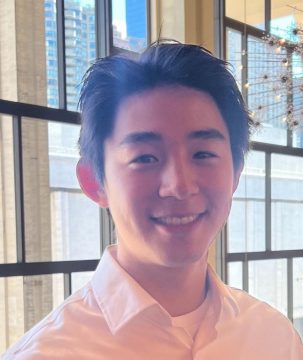Since his first year of medical school, third-year Geisel School of Medicine student Soo Hwan (Soo) Park, who has a background in computer science and neuroimaging, has been involved in a study with his mentor, Mary Brunette MD, a professor of psychiatry and of community & family medicine, looking for clues in the brain to explain why some people with schizophrenia have a high rate of comorbid cannabis use disorder.
Park received an American Academy of Neurology (AAN) Medical Student Research Scholarship to work on this project with Brunette, an addiction psychiatrist who has long been involved in research and clinical care of patients with severe mental illnesses and co-occurring substance abuse.

He recently gave an oral presentation on his neuroimaging fMRI research on the potential "self-medication" function of cannabis in patients with schizophrenia and comorbid cannabis use disorder for the Behavioral and Cognitive Neurology session during the 2023 Annual AAN Meeting.
Cannabis use disorder is common in patients with schizophrenia; nearly 40 percent of patients are heavy cannabis users compared to the healthy population, Park says. “Evidence suggests abnormalities in their brain's reward pathways may be driving their behavior.
“When we compared patients with schizophrenia and comorbid cannabis use disorder with healthy controls, we saw abnormal activity in the bilateral caudate as well as the posterior cingulate gyrus—part of the default mode network,” Park says. “And abnormal caudate activation has been consistently observed in many fMRI reward function studies in schizophrenia and cannabis use disorder respectively and have been heavily implicated in addiction research.”
Interestingly, Park notes, consumption of the drug is known to worsen symptoms of psychosis and disease prognosis in patients with schizophrenia, yet they continue to use the drug. “We are exploring possible causes for this to determine why this is the case when it seems to exacerbate their symptoms.”
Based on their findings the researchers speculate the abnormality may reflect a possible drive for self-medication in these patients. “What is also interesting,” Park says, “is that the abnormality in the posterior cingulate cortex, which is one of the hubs of the brain’s default mode network, may be abnormally activated and communicating with the reward network leading to an impaired ability to turn off the default network in patients with schizophrenia. And they may be self-medicating with cannabis because the drug has the potential to normalize the activity in these parts of the brain.”
Park, Brunette, and the research team are now analyzing the full research data set to see whether smoked cannabis or oral dronabinol—a synthetic form of tetrahydrocannabinol (THC)—can normalize reward network activity. They are testing this hypothesis in the dual-diagnosis group against three control groups: schizophrenia-only, cannabis use disorder-only, and healthy controls.
“I like the nervous system because it models and regulates the intersection between our body and our lived experiences in the external world. Though schizophrenia is primarily considered a psychiatric disorder, both psychiatry and neurology deal with the same organ and the problem of psychosis. I want to use my background in neuroimaging and computer science to continue solving this problem,” Park says.
Their research findings were recently discussed in Neurology Today, Functional MRI Offers Clues to Schizophrenia and Comorbid Cannabis Disorder